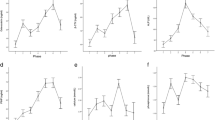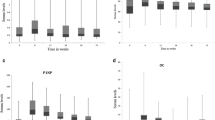Abstract
Time-dependent changes in bone markers in delayed or nonunion of vertebral fracture were compared with those of normal union. Thirty-three patients with a fresh vertebral fracture were enrolled. Urinary Type I collagen C-terminal telopeptide, pyridinoline, deoxypyridinoline, serum C-terminal telopeptide, and N-midportion of osteocalcin (OCN-mid) were determined at the time of hospital admission (within 24 hours after the fracture event in all cases) and at 2, 4, 12, 24, and 48 weeks thereafter. Subjects were divided into two groups according to the results of MR images taken 48 weeks after fracture. Twenty-four were normally united (Group N) and nine had delayed or nonunion (Group D) of the spine. No differences between values of bone resorption markers in Group N and Group D were observed at any time. Serum OCN-mid in Group N started to increase at 2 weeks and reached the peak value at 24 weeks (180%); however, serum OCN-mid in Group D increased at most 120% from baseline to 4 weeks. Values of serum OCN-mid in Group N were higher at 24 and 48 weeks than those in Group D. Impairment of fracture healing was strongly associated with a deficit in the increase of osteocalcin in the later stage of fracture repair.
Level of Evidence: Level II, prognostic study. See the Guidelines for Authors for a complete description of levels of evidence.









Similar content being viewed by others
References
Akedo Y, Hosoi T, Inoue S, Ikegami A, Mizuno Y, Kaneki M, Nakamura T, Ouchi Y, Orimo H. Vitamin K2 modulates proliferation and function of osteoblastic cells in vitro. Biochem Biophys Res Commun. 1992;187:814–820.
Akesson K, Käkönen SM, Josefsson PO, Karlsson MK, Obrant KJ, Pettersson K. Fracture-induced changes in bone turnover: a potential confounder in the use of biochemical markers in osteoporosis. J Bone Miner Metab. 2005;23:30–35.
Baur A, Stäbler A, Arbogast S, Duerr HR, Bartl R, Reiser M. Acute osteoporotic and neoplastic vertebral compression fractures: fluid sign at MR imaging. Radiology. 2002;225:730–735.
Bonde M, Garnero P, Fledelius C, Qvist P, Delmas PD, Christiansen C. Measurement of bone degradation products in serum using antibodies reactive with an isomerized form of an 8 amino acid sequence of the C-telopeptide of type I collagen. J Bone Miner Res. 1997;12:1028–1034.
Bonde M, Qvist P, Fledelius C, Riis BJ, Christiansen C. Immunoassay for quantifying type I collagen degradation products in urine evaluated. Clin Chem. 1994;40(11 Pt 1):2022–2025.
Chalidis B, Tzioupis C, Tsiridis E, Giannoudis PV. Enhancement of fracture healing with parathyroid hormone: preclinical studies and potential clinical applications. Expert Opin Investig Drugs. 2007;16:441–449.
Chow YW, Inman C, Pollintine P, Sharp CA, Haddaway MJ, el Masry W, Davie MW. Ultrasound bone densitometry and dual energy x-ray absorptiometry in patients with spinal cord injury: a cross-sectional study. Spinal Cord. 1996;34:736–741.
Emami A, Larsson A, Petrén-Mallmin M, Larsson S. Serum bone markers after intramedullary fixed tibial fractures. Clin Orthop Relat Res. 1999;368:220–229.
Genant HK, Wu CY, Van Kuijk C, Nevitt MC. Vertebral fracture assessment using a semiquantitative technique. J Bone Miner Res. 1993;8:1137–1148.
Hasegawa K, Homma T, Takahashi HE. Osteosynthesis without instrumentation for vertebral pseudarthrosis in the osteoporotic spine. J Bone Joint Surg Br. 1997;79:452–456.
Hedström M, Sjöberg K, Svensson J, Brosjö E, Dalén N. Changes in biochemical markers of bone metabolism and BMD during the first year after a hip fracture. Acta Orthop Scand. 2001;72:248–251.
Hoesel LM, Wehr U, Rambeck WA, Schnettler R, Heiss C. Biochemical bone markers are useful to monitor fracture repair. Clin Orthop Relat Res. 2005;440:226–232.
Ingle BM, Hay SM, Bottjer HM, Eastell R. Changes in bone mass and bone turnover following ankle fracture. Osteoporos Int. 1999;10:408–415.
Ivaska KK, Gerdhem P, Akesson K, Garnero P, Obrant KJ. Effect of fracture on bone turnover markers: a longitudinal study comparing marker levels before and after injury in 113 elderly women. J Bone Miner Res. 2007;22:1155–1164.
Joerring S, Krogsgaard M, Wilbek H, Jensen LT. Collagen turnover after tibial fractures. Arch Orthop Trauma Surg. 1994;113:334–336.
Kurdy NM. Serology of abnormal fracture healing: the role of PIIINP, PICP, and BsALP. J Orthop Trauma. 2000;14:48–53.
Lueken SA, Arnaud SB, Taylor AK, Baylink DJ. Changes in markers of bone formation and resorption in a bed rest model of weightlessness. J Bone Miner Res. 1993;8:1433–1438.
McKiernan F, Faciszewski T. Intravertebral clefts in osteoporotic vertebral compression fractures. Arthritis Rheum. 2003;48:1414–1419.
Nyman MT, Paavolainen P, Forsius S, Lamberg-Allardt C. Clinical evaluation of fracture healing by serum osteocalcin and alkaline phosphatase. Ann Chir Gynaecol. 1991;80:289–293.
Obrant KJ, Merle B, Bejui J, Delmas PD. Serum bone-gla protein after fracture. Clin Orthop Relat Res. 1990;258:300–303.
Ohishi T, Takahashi M, Kushida K, Hoshino H, Tsuchikawa T, Naitoh K, Inoue T. Changes of biochemical markers during fracture healing. Arch Orthop Trauma Surg. 1998;118:126–130.
Oni OO, Mahabir JP, Iqbal SJ, Gregg PJ. Serum osteocalcin and total alkaline phosphatase levels as prognostic indicators in tibial shaft fractures. Injury. 1989;20:37–38.
Pratt DA, Daniloff Y, Duncan A, Robins SP. Automated analysis of the pyridinium crosslinks of collagen in tissue and urine using solid-phase extraction and reversed-phase high-performance liquid chromatography. Anal Biochem. 1992;207:163–175.
Rosenquist C, Qvist P, Bjarnason N, Christiansen C. Measurement of a more stable region of osteocalcin in serum by ELISA with two monoclonal antibodies. Clin Chem. 1995;41:1439–1445.
Shih TT, Tsuang YH, Huang KM, Chen PQ, Su CT. Magnetic resonance imaging of vertebral compression fractures. J Formos Med Assoc. 1996;95:313–319.
Stoffel K, Engler H, Kuster M, Riesen W. Changes in biochemical markers after lower limb fractures. Clin Chem. 2007;53:131–134.
Sugiyama K, Yamasaki K, Kitagaki H, Tanaka Y, Kono M. Bone marrow disease of the spine: differentiation with T1 and T2 relaxation times in MR imaging. Radiology. 1987;165:541–544.
Sung MS, Park SH, Lee JM, Jung HJ, Yim JI, Kim YS, Shinn KS. Sequential changes of traumatic vertebral compression fracture on MR imaging. J Korean Med Sci. 1995;10:189–194.
Thomas T. Intermittent parathyroid hormone therapy to increase bone formation. Joint Bone Spine. 2006;73:262–269.
Van der Poest Clement E, Van Engeland M, Adèr H, Roos JC, Patka O, Lips P. Alendronate in the prevention of bone loss after a fracture of the lower leg. J Bone Miner Res. 2002;17:2247–2255.
Zehnder Y, Lüthi M, Michel D, Knecht H, Perrelet R, Neto I, Kraenzlin M, Zäch G, Lippuner K. Long-term changes in bone metabolism, bone mineral density, quantitative ultrasound parameters, and fracture incidence after spinal cord injury: a cross-sectional observational study in 100 paraplegic men. Osteoporos Int. 2004;15:180–189.
Acknowledgments
We thank Takuya Tsuchikawa, Mitsuke Clinic, Iwata, Japan, and Ryuichi Miyamoto for sampling the data of the patients.
Author information
Authors and Affiliations
Corresponding author
Additional information
Each author certifies that he or she has no commercial associations (eg, consultancies, stock ownership, equity interest, patent/licensing arrangements, etc) that might pose a conflict of interest in connection with the submitted article.
Each author certifies that his or her institution either has waived or does not require approval for the human protocol for this investigation and that all investigations were conducted in conformity with ethical principles of research.
About this article
Cite this article
Ohishi, T., Takahashi, M., Yamanashi, A. et al. Sequential Changes of Bone Metabolism in Normal and Delayed Union of the Spine. Clin Orthop Relat Res 466, 402–410 (2008). https://doi.org/10.1007/s11999-007-0054-x
Received:
Accepted:
Published:
Issue Date:
DOI: https://doi.org/10.1007/s11999-007-0054-x




